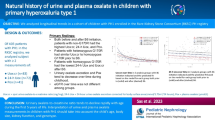Abstract
Purpose
American Urology Association guidelines recommend genetic testing for patients with recurrent stones and urine oxalate > 75 mg/day. The goal of this study was to examine the treatment of patients in this category in a large multidisciplinary adult stone clinic.
Methods
Patients were evaluated from a single institution between 2006 and 2019. Those with at least one level of urinary oxalate excretion (uOx) above 75 mg/day were identified. A chart review identified enteric risk factors and genetic testing results. Patients without an identifiable enteric cause were considered idiopathic.
Results
A total of 4229 separate 24-h urine collections in 1302 patients were reviewed. At least one measurement of uOx above 75 mg/day was found in 103 (7.9%) patients. Enteric hyperoxaluria (EH) was seen in 28 (27%) and idiopathic hyperoxaluria (IH) in 76 (74%). 20 (71%) patients in the EH group had undergone gastric bypass. The median uOx was significantly higher level in the EH group (121.0 vs. 93.0 mg/day). For the entire cohort, there was a drop in uOx (− 33.8 mg/day) with medical and dietary therapy after a follow-up of 46.6 months. The final oxalate was higher in EH (88.9 vs. 60.1 mg/day). Only one patient had referral for genetic testing and was found to have primary hyperoxaluria type 2.
Conclusions
The most common cause of significant hyperoxaluria in patients with recurrent nephrolithiasis remains idiopathic. Patients with IH have more significant improvement in uOx compared to EH; however, both groups had hyperoxaluria at last follow-up. Rate of genetic testing is low despite guideline recommendations.
Similar content being viewed by others
Availability of data and materials
Data available upon request.
Code availability
N/A.
References
Scales CD Jr et al (2012) Prevalence of kidney stones in the United States. Eur Urol 62(1):160–165
Morgan MS, Pearle MS (2016) Medical management of renal stones. BMJ 352:i52
Edvardsson VO et al (2013) Hereditary causes of kidney stones and chronic kidney disease. Pediatr Nephrol 28(10):1923–1942
Monico CG et al (2002) Potential mechanisms of marked hyperoxaluria not due to primary hyperoxaluria I or II. Kidney Int 62(2):392–400
Pearle MS et al (2014) Medical management of kidney stones: AUA guideline. J Urol 192(2):316–324
Hoppe B (2012) An update on primary hyperoxaluria. Nat Rev Nephrol 8(8):467–475
Cochat P et al (2012) Primary hyperoxaluria Type 1: indications for screening and guidance for diagnosis and treatment. Nephrol Dial Transplant 27(5):1729–1736
Cochat P, Rumsby G (2013) Primary hyperoxaluria. N Engl J Med 369(7):649–658
Chandrashekar KB, Fulop T, Juncos LA (2012) Medical management and prevention of nephrolithiasis. Am J Med 125(4):344–347
Ravikumar Y, Begum RF, Velmurugan R (2021) Oxalobacter formigenes reduce the risk of kidney stones in patients exposed to oral antibiotics: a case-control study. Int Urol Nephrol 53(1):13–20
Garrelfs S et al (2020) Illuminate-a, a Phase 3 Study of Lumasiran, an Investigational RNAi Therapeutic, in Children and Adults with Primary Hyperoxaluria Type 1 (Ph1). Nephrol Dial Transpl 35:2183–2183
Witting C et al (2020) Pathophysiology and treatment of enteric hyperoxaluria. Clin J Am Soc Nephrol 16(3):487–495
Dobbins JW, Binder HJ (1976) Effect of bile salts and fatty acids on the colonic absorption of oxalate. Gastroenterology 70(6):1096–1100
Waikar SS et al (2019) Association of urinary oxalate excretion with the risk of chronic kidney disease progression. JAMA Intern Med 179(4):542–551
Li B et al (2021) Association between aortic calcification and the presence of kidney stones: calcium oxalate calculi in focus. Int Urol Nephrol 54(8):1915–1923
Funding
No funding sources were used for the conduct of the study.
Author information
Authors and Affiliations
Contributions
JM—study design, data collection, data analysis, manuscript preparation and review. DM—study design, data collection, and data analysis. GN—manuscript preparation and review. KS—manuscript preparation and review. MH—manuscript preparation and review. MK—study design, manuscript preparation and review.
Corresponding author
Ethics declarations
Conflict of interest
Mitchell Humphreys disclosures unrelated to current research study with Boston Scientific (research support), Adva-Tech (research support), and J&J (consultant). The other authors have no relevant financial or non-financial interests to disclose.
Ethical approval
Institutional Review Board approval was obtained for the conduct of this study. Waiver of Health Insurance Portability and Accountability Act (HIPAA) authorization obtained.
Consent to participate
No formal consent obtained as no identifiable data collected in retrospective review.
Consent for publication
No formal consent obtained as no identifiable data collected in retrospective review.
Additional information
Publisher's Note
Springer Nature remains neutral with regard to jurisdictional claims in published maps and institutional affiliations.
Rights and permissions
Springer Nature or its licensor holds exclusive rights to this article under a publishing agreement with the author(s) or other rightsholder(s); author self-archiving of the accepted manuscript version of this article is solely governed by the terms of such publishing agreement and applicable law.
About this article
Cite this article
Moore, J.P., Mauler, D.J., Narang, G.L. et al. Etiology, urine metabolic risk factors, and urine oxalate patterns in patients with significant hyperoxaluria and recurrent nephrolithiasis. Int Urol Nephrol 54, 2819–2825 (2022). https://doi.org/10.1007/s11255-022-03311-4
Received:
Accepted:
Published:
Issue Date:
DOI: https://doi.org/10.1007/s11255-022-03311-4




